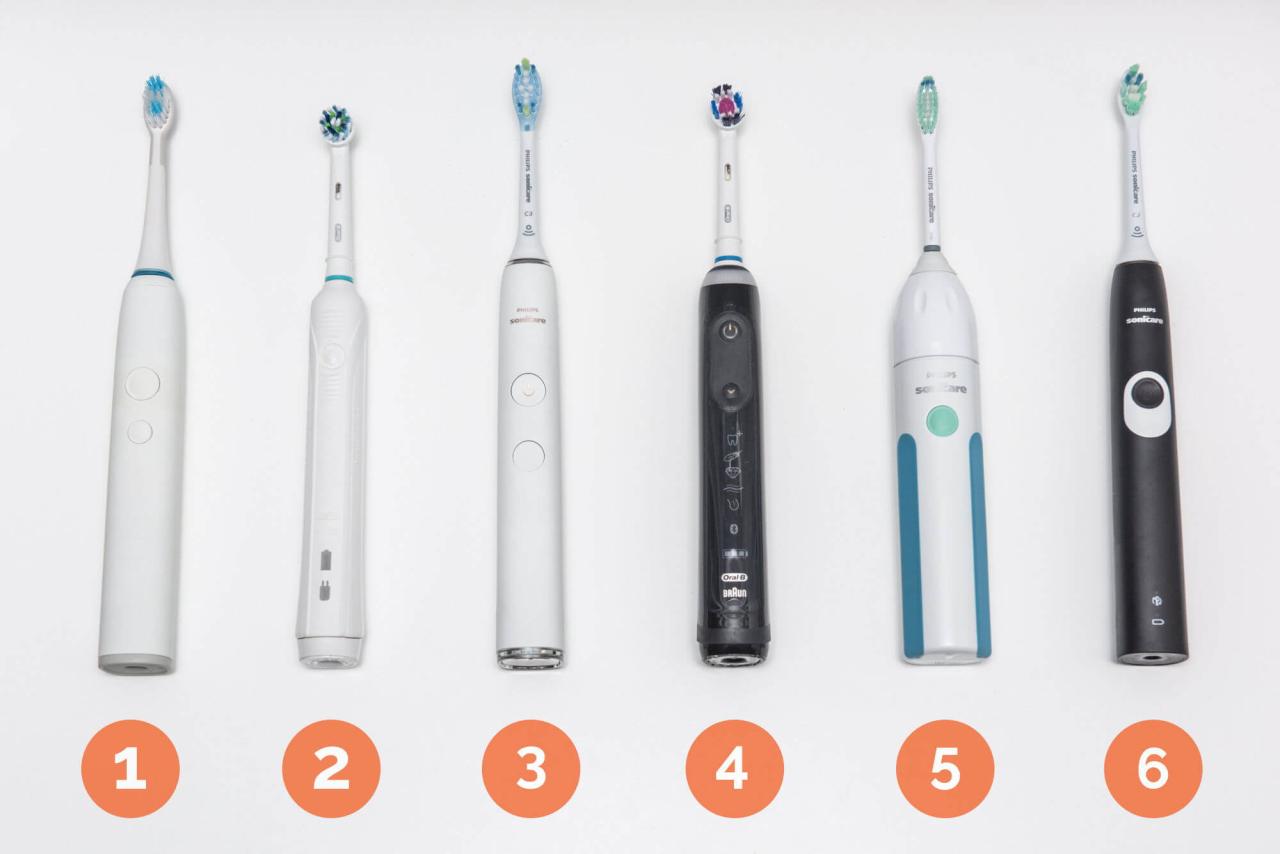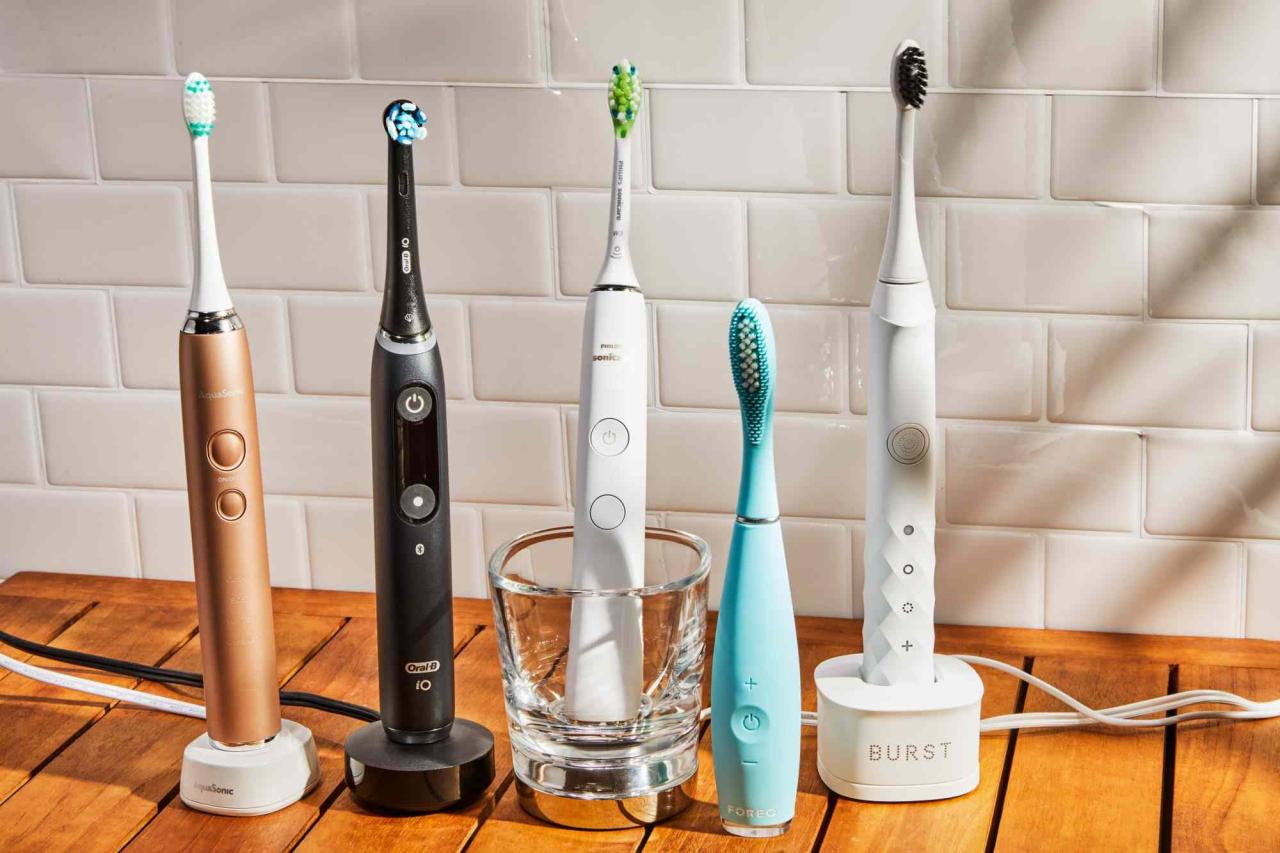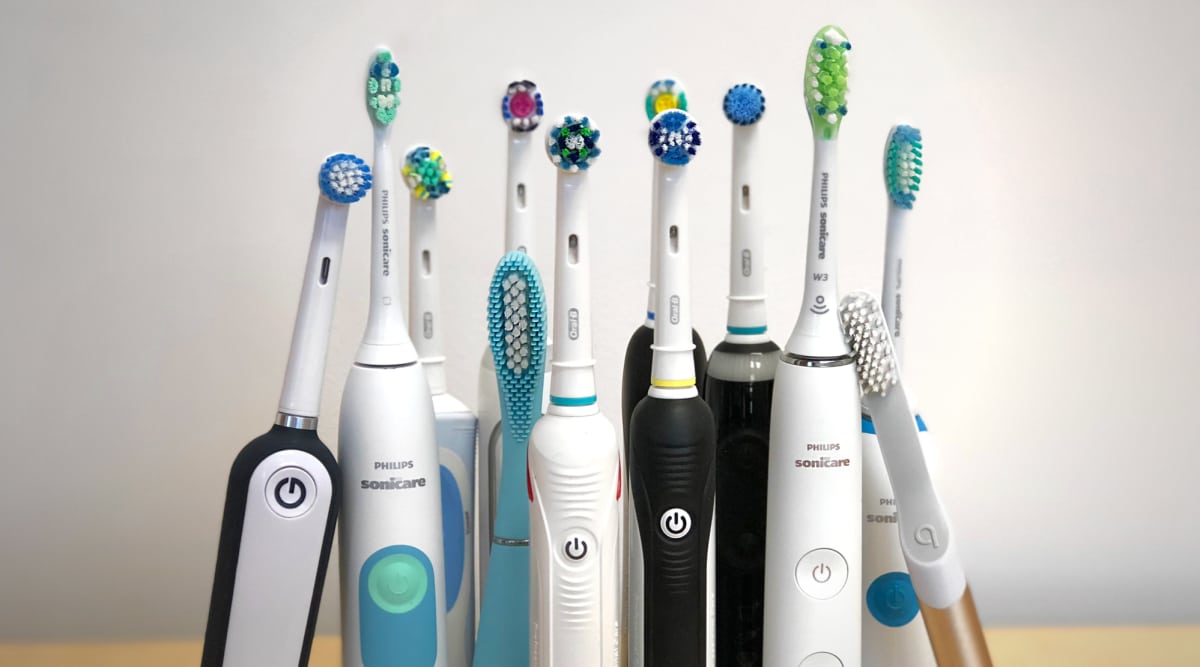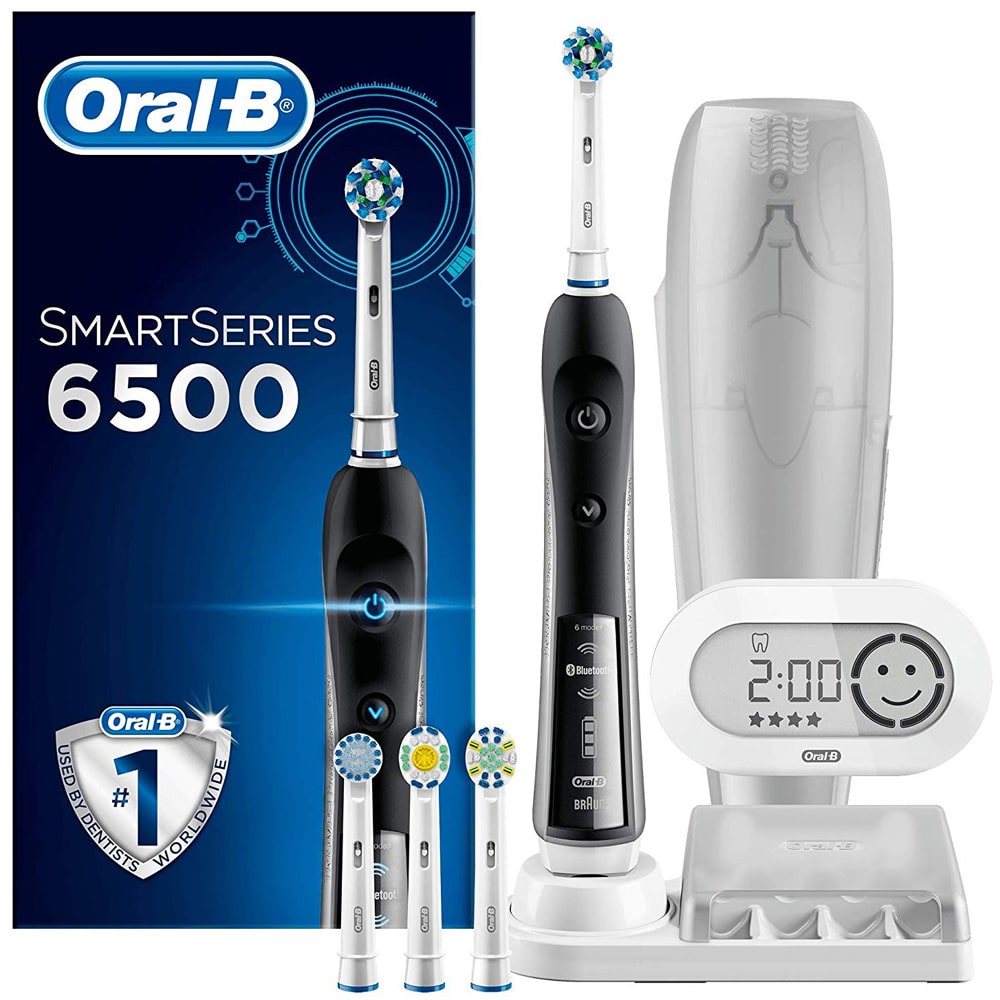The electric toothbrush has become a staple in modern oral hygiene routines, offering a more effective and convenient way to brush compared to traditional manual toothbrushes. With a wide range of models available, choosing the right electric toothbrush can feel overwhelming.
This guide explores the features, benefits, and considerations for selecting the best electric toothbrush for your needs, from basic models to advanced smart toothbrushes.
We delve into the history of electric toothbrushes, their evolution, and the different types available, including sonic, oscillating, and rotating models. We examine key features to consider when making your decision, such as brush head type, timer, pressure sensor, and brushing modes.
We also provide a comprehensive comparison of top electric toothbrush brands and models, highlighting their pros and cons to help you make an informed choice.
Introduction to Electric Toothbrushes
Electric toothbrushes have become increasingly popular in recent years, offering a more effective and efficient way to clean teeth compared to traditional manual toothbrushes. These devices utilize powered bristles to remove plaque and bacteria, leading to improved oral hygiene and a healthier smile.
The history of electric toothbrushes dates back to the early 20th century, with the first commercially available model being introduced in 1960. Early models were bulky and expensive, but technological advancements have led to smaller, more powerful, and feature-rich electric toothbrushes available today.
Types of Electric Toothbrushes
Electric toothbrushes come in various types, each with unique features and benefits. Understanding these differences can help consumers choose the best option for their needs.
- Rotary Electric Toothbrushes:These brushes have a round brush head that rotates in a circular motion. They are generally considered effective at removing plaque and are a good choice for people with sensitive gums.
- Oscillating-Rotating Electric Toothbrushes:These brushes combine both oscillating and rotating motions to effectively clean teeth and gums. They are often preferred for their ability to remove plaque and bacteria from hard-to-reach areas.
- Sonic Electric Toothbrushes:These brushes use high-frequency vibrations to create a sonic wave that dislodges plaque and bacteria. They are known for their ability to clean teeth and gums more gently than other types of electric toothbrushes.
Features to Consider When Choosing an Electric Toothbrush

Choosing the right electric toothbrush can be a daunting task, given the vast array of models available on the market. However, by understanding the key features to consider, you can make an informed decision that aligns with your needs and budget.
Brush Head Types
The brush head is the most important part of an electric toothbrush, as it directly interacts with your teeth and gums. Different brush head types cater to various oral health needs and preferences.
- Soft-bristled brush headsare the most common and gentle option, suitable for most people. They effectively remove plaque and bacteria without irritating gums.
- Medium-bristled brush headsoffer a slightly more aggressive cleaning experience, suitable for individuals with tougher stains or thicker plaque buildup. However, they can be harsher on gums and should be used with caution.
- Hard-bristled brush headsare not recommended for regular use, as they can damage enamel and irritate gums. They may be suitable for specific situations, such as removing stubborn stains, but should be used sparingly.
- Interdental brush headsare designed to clean between teeth, where traditional brush heads may not reach. They are particularly beneficial for individuals with crowded teeth or those who are prone to gum disease.
- Tongue cleaning brush headsare specifically designed to remove bacteria and debris from the tongue, improving breath freshness and overall oral hygiene.
Timer and Pressure Sensor
These features play a crucial role in optimizing your brushing experience and ensuring proper oral hygiene.
- Timer: Most electric toothbrushes incorporate a timer that signals when to switch to a different quadrant of the mouth, ensuring equal brushing time for all areas. This helps prevent over-brushing of certain areas and under-brushing of others.
- Pressure sensor: This feature alerts you if you are brushing too hard, which can damage gums and enamel. It encourages gentle brushing, promoting optimal cleaning without causing harm.
Brushing Modes
Modern electric toothbrushes often offer multiple brushing modes to cater to different needs and preferences.
- Clean modeis the standard mode for everyday use, providing a thorough cleaning experience.
- Sensitive modeuses gentler vibrations and lower speeds, suitable for individuals with sensitive teeth or gums.
- Whitening modeoften incorporates higher-frequency vibrations or specialized brush heads to help remove surface stains and brighten teeth.
- Gum care modefocuses on massaging and stimulating gums, improving blood circulation and promoting gum health.
Top Electric Toothbrush Brands and Models
The electric toothbrush market is crowded with a wide range of brands and models, each with unique features and price points. Finding the right electric toothbrush can be overwhelming, but understanding the key features and top brands can help you make an informed decision.
Top Electric Toothbrush Brands and Models
Here’s a table showcasing some of the top electric toothbrush brands and their popular models:
| Brand | Model | Key Features | Price Range |
|---|---|---|---|
| Oral-B | Oral-B iO Series 9 | AI-powered brushing guidance, personalized modes, magnetic drive technology, pressure sensor | $250-$350 |
| Philips Sonicare | Philips Sonicare DiamondClean 9000 | Sonic technology, multiple brushing modes, smart sensor technology, travel case | $200-$300 |
| Waterpik | Waterpik Sonic Fusion | Combination of sonic brushing and water flossing, multiple brushing modes, plaque removal technology | $150-$200 |
| Bursten | Bursten Sonic Electric Toothbrush | High-frequency sonic vibrations, multiple brushing modes, long battery life, affordable price | $50-$100 |
Comparing and Contrasting Popular Models
The Oral-B iO Series 9 and Philips Sonicare DiamondClean 9000 are considered premium electric toothbrushes with advanced features. The Oral-B iO Series 9 uses a magnetic drive technology that provides a more powerful and efficient brushing experience, while the Philips Sonicare DiamondClean 9000 relies on sonic vibrations to remove plaque and bacteria.
Both models offer personalized brushing modes, pressure sensors, and smart sensor technology to optimize your brushing routine.The Waterpik Sonic Fusion combines the benefits of sonic brushing and water flossing, making it a suitable option for individuals with braces or dental implants.
This model offers multiple brushing modes and plaque removal technology, providing a comprehensive oral care solution.The Bursten Sonic Electric Toothbrush is a more affordable option that still delivers effective cleaning. It features high-frequency sonic vibrations, multiple brushing modes, and a long battery life.
While it may not have the advanced features of premium models, it provides a solid brushing experience at a reasonable price.
Advantages and Disadvantages of Specific Models
Oral-B iO Series 9
Advantages
Powerful and efficient cleaning, personalized brushing modes, AI-powered guidance, pressure sensor
Disadvantages
Higher price point, may be too powerful for sensitive gums Philips Sonicare DiamondClean 9000
Advantages
Sonic technology for effective plaque removal, multiple brushing modes, smart sensor technology, travel case
Disadvantages
Higher price point, may not be suitable for individuals with sensitive teeth Waterpik Sonic Fusion
Advantages
Combination of sonic brushing and water flossing, comprehensive oral care solution, multiple brushing modes
Disadvantages
Higher price point, may be bulky and inconvenient for travel Bursten Sonic Electric Toothbrush
Advantages
Affordable price, high-frequency sonic vibrations, multiple brushing modes, long battery life
Disadvantages
May not have the advanced features of premium models, may not be as effective for deep cleaning
Benefits of Using an Electric Toothbrush
Electric toothbrushes have become increasingly popular in recent years, and for good reason. They offer a range of benefits over manual toothbrushes, leading to improved oral hygiene and overall health.
Improved Plaque Removal
Electric toothbrushes are significantly more effective at removing plaque than manual toothbrushes. The oscillating, rotating, or sonic vibrations of electric toothbrushes help to break down plaque and bacteria, leaving teeth cleaner and healthier.
A 2014 study published in the Journal of Clinical Periodontology found that electric toothbrushes removed 22% more plaque than manual toothbrushes.
Enhanced Gum Health
Electric toothbrushes can also improve gum health. The gentle vibrations and pulsations of electric toothbrushes stimulate blood flow to the gums, promoting healthy tissue and reducing inflammation.
Research has shown that using an electric toothbrush can reduce gingivitis (gum inflammation) by up to 22% compared to using a manual toothbrush.
Reduced Risk of Cavities
By removing more plaque and bacteria, electric toothbrushes help to reduce the risk of cavities. Plaque buildup is a major contributor to tooth decay, and electric toothbrushes can help to keep teeth clean and healthy.
A 2015 study published in the American Journal of Dentistry found that electric toothbrushes were more effective at preventing cavities than manual toothbrushes.
How to Use an Electric Toothbrush Effectively
An electric toothbrush can significantly enhance your oral hygiene routine, but only if you use it correctly. Mastering the technique and understanding the nuances of electric brushing is crucial for maximizing its benefits.
Proper Brushing Technique
Using an electric toothbrush effectively requires a different approach compared to a manual brush. Here’s a step-by-step guide:
- Apply a pea-sized amount of fluoride toothpasteto the brush head. Avoid using too much toothpaste, as it can lead to excessive foaming and make it difficult to reach all areas of your mouth.
- Position the brush head at a 45-degree angleagainst the gum line. This angle helps to clean both the teeth and the gum line effectively.
- Use gentle, circular motionsto brush each tooth. Do not press too hard, as this can irritate your gums and damage tooth enamel. The electric toothbrush’s vibrations will do most of the work for you.
- Brush each tooth for a few seconds, ensuring you reach all surfaces, including the outer, inner, and chewing surfaces.
- Don’t forget to brush your tonguefor a few seconds to remove bacteria and freshen breath.
Recommended Brushing Duration
The American Dental Association (ADA) recommends brushing your teeth for a minimum of two minutes, twice a day. Electric toothbrushes often have built-in timers that help you track your brushing time.
Tips and Tricks for Maximizing Benefits
- Choose the right brush headfor your needs. Some brush heads are designed for sensitive gums, while others are better for removing plaque and tartar. Consider consulting your dentist to determine the best brush head for your oral health.
- Replace your brush head regularly. The ADA recommends replacing your brush head every three months or sooner if the bristles become frayed or worn. A worn-out brush head will not clean your teeth effectively and can even damage your gums.
- Don’t forget to floss. Even with an electric toothbrush, flossing is essential for removing plaque and food particles from between your teeth. Flossing helps to prevent cavities and gum disease.
- Use mouthwash. Mouthwash can help to kill bacteria and freshen breath. Choose an ADA-approved mouthwash for optimal results.
- See your dentist regularly. Regular dental checkups and cleanings are essential for maintaining good oral health, regardless of whether you use a manual or electric toothbrush. Your dentist can also provide personalized advice on oral hygiene and help you choose the best electric toothbrush for your needs.
Electric Toothbrushes for Specific Needs

Electric toothbrushes offer personalized solutions for various oral health needs, providing a tailored approach to oral hygiene. They are designed to cater to specific requirements, ensuring optimal cleaning and care for individuals with unique dental concerns.
Electric Toothbrushes for Sensitive Teeth
Electric toothbrushes with soft bristles and gentle vibrations are ideal for individuals with sensitive teeth. They effectively remove plaque and bacteria without causing irritation or discomfort.
Many electric toothbrushes feature a “sensitive” mode that reduces the brushing intensity, providing a more gentle cleaning experience.
Here are some features to consider when choosing an electric toothbrush for sensitive teeth:
- Soft Bristles:Opt for toothbrushes with soft bristles that are gentle on gums and enamel.
- Pressure Sensors:Some models feature pressure sensors that alert users if they are brushing too hard, preventing gum irritation.
- Multiple Brushing Modes:Look for toothbrushes with multiple brushing modes, including a “sensitive” or “soft” mode that reduces vibration intensity.
Electric Toothbrushes for Braces
Maintaining oral hygiene with braces can be challenging, but electric toothbrushes can simplify the process. Electric toothbrushes with specialized brush heads designed for braces effectively clean around and under wires, ensuring optimal plaque removal.
- Interdental Brush Heads:These brush heads are designed with angled bristles that reach between teeth and under wires, effectively cleaning hard-to-reach areas.
- Oscillating-Rotating Technology:This technology combines oscillating and rotating movements to provide a thorough cleaning around braces.
- Compact Brush Heads:Smaller brush heads are ideal for navigating around braces and reaching tight spaces.
Electric Toothbrushes for Children
Children’s electric toothbrushes are designed with smaller brush heads and fun features to make brushing more enjoyable. They also have lower vibration levels, making them suitable for sensitive gums and developing teeth.
- Colorful Designs and Characters:Engaging designs and popular characters can motivate children to brush regularly.
- Timers and Song Modes:These features help children brush for the recommended two minutes, making brushing more interactive and fun.
- Small Brush Heads:Smaller brush heads are easier for children to maneuver and reach all areas of their mouths.
Electric Toothbrushes for Adults
Electric toothbrushes for adults offer advanced features and technology to enhance oral hygiene and address specific concerns.
- Smart Features:Some models connect to smartphone apps, providing personalized brushing recommendations and tracking progress.
- Multiple Brushing Modes:Advanced electric toothbrushes offer various brushing modes, including whitening, deep clean, and gum care, to cater to individual needs.
- Long Battery Life:Electric toothbrushes with long battery life ensure uninterrupted brushing, eliminating the need for frequent charging.
Electric Toothbrushes for Specific Oral Health Conditions
Electric toothbrushes can be beneficial for individuals with specific oral health conditions, such as gum disease, gingivitis, and receding gums.
- Gum Massage Modes:Some electric toothbrushes feature gum massage modes that stimulate blood flow and improve gum health.
- Sonic Technology:Sonic toothbrushes use high-frequency vibrations to remove plaque and bacteria, promoting gum health.
- Specialized Brush Heads:Electric toothbrushes with specialized brush heads designed for gum care can gently clean and massage gums, promoting overall oral health.
Maintaining and Caring for Your Electric Toothbrush

Just like any other electronic device, your electric toothbrush requires proper care and maintenance to ensure optimal performance and longevity. Neglecting these essential steps can lead to reduced effectiveness, premature wear, and even damage to your toothbrush.
Cleaning and Disinfecting the Brush Head and Charging Base
Maintaining hygiene is crucial for both the brush head and the charging base. Bacteria and germs can accumulate over time, potentially affecting your oral health. Here’s how to keep your electric toothbrush clean:
- Brush Head Cleaning:After each use, rinse the brush head thoroughly under running water. Remove any visible debris or toothpaste residue. For deeper cleaning, you can soak the brush head in a disinfectant solution specifically designed for electric toothbrushes, following the manufacturer’s instructions.
- Charging Base Cleaning:Regularly wipe down the charging base with a damp cloth to remove any dust or debris. Avoid submerging the base in water. You can also use a mild disinfectant solution, but be sure to dry it completely afterward.
Replacing Brush Heads
Brush heads wear down over time, losing their effectiveness and potentially harming your gums. Replacing them regularly is essential for maintaining optimal oral hygiene.
- Recommended Replacement Frequency:Most manufacturers recommend replacing brush heads every 3 months or sooner if they show signs of wear, such as frayed bristles or discoloration.
- Signs of Wear:Look for signs of wear such as frayed bristles, discoloration, or a loss of firmness. If you notice any of these signs, it’s time to replace the brush head.
Extending the Lifespan of Your Electric Toothbrush
By following these simple tips, you can extend the lifespan of your electric toothbrush:
- Avoid Extreme Temperatures:Do not expose your electric toothbrush to extreme temperatures, such as direct sunlight or hot water.
- Store Properly:Store your toothbrush in a dry and well-ventilated area, preferably in a travel case when not in use.
- Avoid Dropping:Handle your toothbrush with care and avoid dropping it.
- Clean Regularly:Regularly clean both the brush head and charging base to prevent the buildup of bacteria and germs.
- Replace Brush Heads:Replace brush heads according to the manufacturer’s recommendations or sooner if they show signs of wear.
Electric Toothbrush vs. Manual Toothbrush
Choosing the right toothbrush can significantly impact your oral health. While manual toothbrushes have been the standard for decades, electric toothbrushes have gained popularity due to their advanced features and effectiveness. This section will delve into a comparison of electric and manual toothbrushes, highlighting their advantages, disadvantages, and factors to consider when making a decision.
Effectiveness
The effectiveness of a toothbrush depends on its ability to remove plaque and bacteria from teeth and gums. Both electric and manual toothbrushes can be effective when used correctly. However, studies have shown that electric toothbrushes generally remove more plaque and reduce gingivitis (inflammation of the gums) more effectively than manual toothbrushes.
Electric toothbrushes, especially those with oscillating-rotating heads, have been shown to remove up to 22% more plaque than manual toothbrushes.
This is because electric toothbrushes typically have faster and more consistent brush strokes, making them more efficient at removing plaque and bacteria.
Advantages and Disadvantages
Electric Toothbrushes
- Advantages:
- More effective at removing plaque and bacteria.
- Can improve gum health.
- Easier to use for people with dexterity issues.
- Offer various features, such as timers, pressure sensors, and different brush head options.
- Disadvantages:
- More expensive than manual toothbrushes.
- Require charging or replacement batteries.
- Can be bulky and less portable.
Manual Toothbrushes
- Advantages:
- Less expensive than electric toothbrushes.
- More portable and easier to travel with.
- Do not require charging or batteries.
- Disadvantages:
- Less effective at removing plaque and bacteria.
- Can be harder to use for people with dexterity issues.
- May not reach all areas of the mouth effectively.
Factors to Consider
When deciding between an electric and manual toothbrush, consider the following factors:
- Oral Health Needs:If you have specific oral health concerns, such as gingivitis or sensitive teeth, an electric toothbrush with specific features may be beneficial.
- Budget:Electric toothbrushes are generally more expensive than manual toothbrushes.
- Convenience:Electric toothbrushes require charging or battery replacement, while manual toothbrushes are more convenient for travel.
- Personal Preferences:Ultimately, the best toothbrush is the one you will use consistently. Consider your personal preferences and what you find most comfortable and easy to use.
Electric Toothbrush Accessories and Enhancements

Beyond the basic electric toothbrush, a range of accessories and enhancements can elevate your oral hygiene routine and cater to specific needs. These add-ons provide extra convenience, functionality, and customization, ensuring a more effective and enjoyable brushing experience.
Travel Cases
Travel cases are essential for keeping your electric toothbrush protected and organized while on the go. They typically feature a compact design that fits easily into luggage or a carry-on bag. Many travel cases also include a built-in charging station, allowing you to power up your toothbrush while traveling.
Popular travel cases often include a dedicated compartment for brush heads, ensuring hygiene and preventing damage during transit.
Charging Stations
Charging stations offer a convenient way to power your electric toothbrush without the need for plugging it directly into an outlet. They typically feature a sleek and modern design that complements your bathroom decor.
Some charging stations come with multiple charging slots, allowing you to charge multiple toothbrushes simultaneously.
Specialized Brush Heads
Electric toothbrush brush heads are designed to target specific oral hygiene needs.
- Soft-bristled brush headsare ideal for individuals with sensitive gums or teeth.
- Medium-bristled brush headsare suitable for most users and offer a balance between cleaning effectiveness and gum sensitivity.
- Hard-bristled brush headsare typically recommended for individuals with stubborn plaque buildup, but should be used with caution to avoid damaging gums.
- Interdental brush headsare specifically designed to reach between teeth and clean hard-to-reach areas.
- Tongue cleaning brush headshelp remove bacteria and debris from the tongue, improving breath freshness.
Choosing the right brush head for your needs is crucial for achieving optimal oral hygiene.
Future Trends in Electric Toothbrush Technology
The electric toothbrush market is rapidly evolving, driven by advancements in technology, consumer demand for personalized experiences, and a growing focus on oral health. This innovation is leading to a new generation of electric toothbrushes that are smarter, more personalized, and more effective than ever before.
Smart Features and AI Integration
Smart features are transforming the electric toothbrush experience, enhancing both convenience and effectiveness. These features use sensors, data analysis, and artificial intelligence (AI) to provide real-time feedback and personalized guidance.
- Real-Time Brushing Guidance:Smart toothbrushes use sensors to monitor brushing pressure, duration, and coverage. They provide real-time feedback through LED indicators, app notifications, or voice prompts, guiding users to achieve a thorough and effective clean. For instance, the Oral-B iO Series 9 uses AI to analyze brushing habits and provide personalized feedback through its app.
- Personalized Brushing Modes:Smart toothbrushes can adjust brushing settings based on individual needs and preferences. Users can choose from different modes, such as whitening, sensitive, or gum care, to optimize their brushing experience. For example, the Philips Sonicare 9900 Prestige allows users to create personalized brushing routines based on their specific needs.
- Data Tracking and Analytics:Smart toothbrushes track brushing data, including duration, pressure, and coverage, and store it in a mobile app. This data provides insights into brushing habits and helps users identify areas for improvement. For instance, the Colgate Hum by Oral-B tracks brushing habits and provides personalized recommendations to improve oral hygiene.
Personalized Brushing Experiences
Personalized brushing experiences are becoming increasingly common, allowing users to tailor their brushing routine to their specific needs and preferences.
- Customizable Brushing Modes:Users can select from a range of pre-set brushing modes or create their own custom modes to address specific oral health concerns, such as whitening, gum care, or sensitivity. For example, the Oral-B iO Series 9 allows users to adjust brushing intensity and duration to suit their individual needs.
- Smart Sensors and Feedback:Smart toothbrushes use sensors to monitor brushing habits and provide personalized feedback through LED indicators, app notifications, or voice prompts. This feedback helps users improve their brushing technique and achieve a more effective clean. For example, the Philips Sonicare 9900 Prestige uses AI to analyze brushing habits and provide personalized recommendations through its app.
- Artificial Intelligence (AI):AI-powered toothbrushes are capable of learning individual brushing habits and adapting to them over time. They can provide personalized recommendations, track progress, and even identify potential oral health issues. For example, the Oral-B iO Series 9 uses AI to analyze brushing habits and provide personalized feedback through its app.
Last Point

Ultimately, the best electric toothbrush is the one that fits your individual needs and preferences. By understanding the benefits, features, and considerations Artikeld in this guide, you can make an informed decision and choose the electric toothbrush that will help you achieve a brighter, healthier smile.

